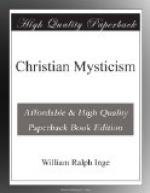not less real than those to which the common superficial
consciousness of mankind bears witness. I agree
with this statement about the basis of Mysticism,
but I prefer to use the word symbol of that which has
a real, and not merely a conventional affinity to
the thing symbolised.[320] The line is by no means
easy to draw. An aureole is not, properly speaking,
a
symbol of saintliness,[321] nor a crown of
royal authority, because in these instances the connexion
of sign with significance is conventional. A
circle is perhaps not a symbol of eternity, because
the comparison appeals only to the intellect.
But falling leaves are a symbol of human mortality,
a flowing river of the “stream” of life,
and a vine and its branches of the unity of Christ
and the Church, because they are examples of the same
law which operates through all that God has made.
And when the Anglian noble, in a well-known passage
of Bede, compares the life of man to the flight of
a bird which darts quickly through a lighted hall out
of darkness, and into darkness again, he has found
a symbol which is none the less valid, because light
and darkness are themselves only symbolically connected
with life and death. The writer who denies that
Mysticism is symbolic, means that the discovery of
arbitrary and fanciful resemblances or types is no
part of healthy Mysticism.[322] In this he is quite
right; and the importance of the distinction which
he wishes to emphasise will, I hope, become clear
as we proceed. It is not possible always to say
dogmatically, “
This is genuine Symbolism,
and
that is morbid or fantastic”; but
we do assert that there is a true and a false Symbolism,
of which the true is not merely a legitimate, but
a necessary mode of intuition; while the latter is
at best a frivolous amusement, and at worst a degrading
superstition.[323]
But we shall handle our subject very inadequately
if we consider only the symbolical value which may
be attached to external objects. Our thoughts
and beliefs about the spiritual world, so far as they
are conceived under forms, or expressed in language,
which belong properly only to things of time and space,
are of the nature of symbols. In this sense it
has been said that the greater part of dogmatic theology
is the dialectical development of mystical symbols.
For instance, the paternal relation of the First Person
of the Trinity to the Second is a symbol; and the
representation of eternity as an endless period of
time stretching into futurity, is a symbol. We
believe that the forms under which it is natural and
necessary for us to conceive of transcendental truths
have a real and vital relation to the ideas which
they attempt to express; but their inadequacy is manifest
if we treat them as facts of the same order as natural
phenomena, and try to intercalate them, as is too
often done, among the materials with which an abstract
science has to deal.




